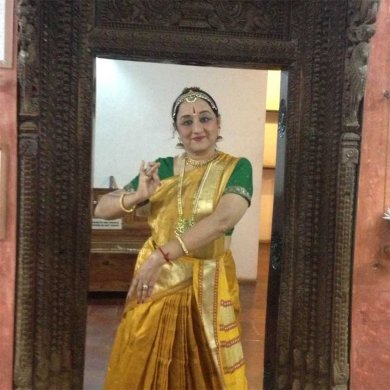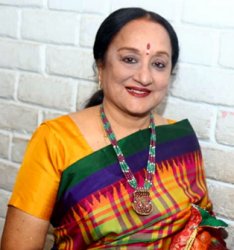
|   |

|   |
The temple doors opened! March 31, 2016  In the last decade, the kshetra that is Kalakshetra has opened its doors to many Bharatanatyam artists to come in and perform, lecture, demonstrate and so on. Leela Samson did quite a few programs giving "chances" to aspirants. This season the doors were opened wider with Priyadarsini Govind organising a Baani festival inviting a number of gurus, teachers and practitioners (YES, gurus are different from teachers!). What took place was very interesting, sometimes intriguing too, and altogether engrossing. I hope that soon Kalakshetra will put together a team to look for hidden and forgotten aficionados of some antique Baanis. They, who have a trunk full of "sarakku" - dance treasures, like original compositions (the disciples of Dandayudhapani Pillai to name one traditional Nattuvanar), and old nrtta compositions (Muthuswamy Pillai) need to be researched, studied, seen and archived. It augurs well for Bharatanatyam, the form of dance that has grown the most to get such a widely seen focus. The web streaming.....ah!....what a lovely age we live in... I was delighted to get responses immediately from Aravinth in the east, Hari and Hema in the west, and many more cool browsers! Future such seminars could lead to the expansion of this public funded dance school in a significant manner. Under THIS banyan tree, all Baanis of Bharatanatyam should be nurtured (taught), archived, revived and made the bench marks for a comprehensive Bharatanatyam form in the new age. It was providential that I was asked to be part of the Baani 2016. And I took the opportunity seriously to talk about my Guru Kanjivaram Ellappa who followed the Tanjavur Baani of Kandappa Pillai. Douglas Knight in his book has mentioned (acknowledged, I would say) that Ellappa conducted the recitals of Balasaraswathi for over a decade.... Hmmmmm....that should explain the ways of my Guru, in repertoire, musicality, nrtta and abhinaya. He KNEW it all, and SAW with clarity the aesthetic aspect of dance. Briefly, here is what I said in my session titled Precision, fluidity and charm of the Tanjavur Baani of Guru Ellappa, illustrating it with my demonstrations. My guru Kanjivaram Ellappa was a disciple of Tanjavur Kandappa Pillai, who was a direct descendant of the famous Tanjore Quartet. Guru Ellappa was a superb singer, and composer. He also played the mridangam with technical facility and knew all aspects of laya in dance. He had been teaching many French students. When I joined he was very happy because, a) there was no language barrier, and to his delight, b) I had trained in Carnatic music under my mother Alamelu Viswanathan and under Thedhiyur Narayanaswamy and Tiruvayyaru Krishnamurthy. Moreover, he approved completely of my young sister Charumathi's singing for the dance because she could learn the whole repertoire easily, being a senior disciple of MLV. Baani is certainly defined by content and repertoire. I listed the core items. I learnt 5 Alarippus in the five Nadais...Thisram, Misram, Chathusram, Khandam and Sankirtanam, each accompanied by a Tiruppugazh of appropriate tala. I also learnt Jathiswarams... Hemavathi, Hindolam, Saraswathi, Poorvikalayni, Kalyani, Chakravaham, Vasantha. And the Varnams....Mohamana in Bhairavi, Useni Swarajathi, Dhanike in Todi, Navaragamalika, Sakiye in Anandabhairavi, Sarasalanu in Kapi, Sami ni Rammanave in Kamas, and the Tana Varnam Viriboni in Bhairavi. I also learnt the Todi ragam Dhanisamajendra of Swati Tirunal. I mention repertoire also because the music and the way the songs were sung (patantharam) always defined the Baani or Vazhi. The varnams, each of which is a delectable composition, were never sung in a dragging slow tempo. They were always brisk, and sparkling. No kutcheri type neravals were ever allowed. No extra flourishes in sangathis.  Guru Ellappa taught crisp and short jathi korvais for the varnams. I demonstrated the longer but not dragging Thrikala jathi, and a short korvai in Dhanike. The footwork has to be firm but not aggressive. The intricacies of karvais...pauses, are arresting. The punch lines in the theermanams are sparkling. Precision was achieved by my Guru in tala and footwork by following the old tradition of different nadais, and variety in movements. Also, the starting point was not always in samam in the tala...the calculated moves were like complex arithmetic. He also trained the mridangist (Sri Nathan) to play counter rhythms and match the sollukattus and the footwork. It was a three way confluence of precise rhythmic patterns. We did thattu mettu for the Varnam's sahityam from the first pallavi line onwards. We also did it once in samam and once in usi. I pointed out that in Useni Swarajathi, in the charanam "Ri, Ri, Ri...." he had composed for me the seven talams in a cascading series of footwork. Phew!... that was indeed challenging. I demonstrated his ideas in the ata tala Viribhoni Varnam also. In the old style, I did the swaras of the Tana Varnam as nrtta, and then did the same as sahitya. This was how we learnt to SING the Varnam also. In the charanam, I showed the Thisra Nadai both in nrtta and abhinaya. Nrtta was always graceful with my Guru insisting on anga suddham with delicate movements. The Sarpa Nadai doing Thisram always captivated audiences whenever I danced it. I listed the Padams in Tamil and Telugu which I learnt, such as Darijoochu, Mogadochi, Ethai Kandu, Indendhu, Yarukkagilum Bhayama, Aduvum Solluval, Tiruvotriyur Tyagarjan, Nidhirayil Soppanathil, and some more, as also Javalis, some kritis, and also some Viruttams and Slokams. My guru was very particular about the kalapramanam of Padams and Javalis. Also in choice of ragas for Viruttams. No changes were allowed. Precision always combined with fluidity in my abhinaya.....the slowest Padam in Thisra Triputa Talam, Darijoochu Chunnathi in Sankarabaranam, requires precise footwork, to coincide with the talam, (no standing in one place and doing only gestures) and fluid movements of the body where the gamakas of the song, and the raga bhava are followed by the whole body, as well as the gestures. My abhinaya is a reflection of the song's contours. The whole is enhanced by fluid facial expressions where the sthayi bhava is maintained with all variations of the Nayika, like Vasaka Sajjika Nayika.....showing her anticipation, anxiety, eagerness, restlessness, yearning, longing, doubting, preparedness, etc. with a mood of sringara pervading all her actions. In this style crafted in the Tanjavur tradition, grace or nalinam is important. The charm of dance pervades the whole approach in my style be it a playful love song like Aduvum Solluval or a Vipralamba as in Vadaraka Pove (Adhi okka Yugamu ) in Kambodhi. Based on the foundation laid by Guru Ellappa, I myself took up several songs for dance, particularly Padams and Javalis numbering more than fifty. With painstaking effort my vocal support have mastered the technique where fluidity of raga bhava pervades as they sing, one in a high octave and the other in the low octave giving the dance and music a special harmony....I call my abhinaya visual music. I also pointed out that the word choreography does not apply to doing a Padam. I dance padams based on my study of the text and sub text and expand on the core idea with my use of the body language which I have painstakingly studied and mastered. No fixed choreography is possible in a Padam which changes like the colours of an evening sky. In short, I imbibed the magic of precision, fluidity and charm in dance from a renowned Guru and built my own imaginative repertoire on this strong foundation. Jai Ho to traditional Tanjavur Baani Bharatanatyam!  Lakshmi Vishwanathan, a prime disciple of Guru Kanjeevaram Elappa Pillai, is an exponent of the Thanjavur style of Bharatanatyam. She is also a trained vocalist. She is the author of several acclaimed books: Bharatanatyam - the Tamil Heritage, Kunjamma - Ode to a Nightingale, Kapaleeswara Temple, Women of Pride -The Devadasi Heritage. Her film 'The Poetry of Dance' was commissioned by the Festival of India. The Mamallapuram Dance Festival started in 1991 was Lakshmi's brainchild. She has served on several arts committees. She has served as Vice President of Music Academy (Chennai) and is a member of South Zone Cultural Centre. Comments Lakshmi's knowledge and erudition is phenomenal. I admire her for it. I have had the chance of seeing her dance a couple of times during our school days. (We were in the same school). - Tapati Chowdhurie (April 19, 2016) Post your comments Pl provide your name and email id along with your comment. All appropriate comments posted with name and email id in the blog will also be featured in the site. |